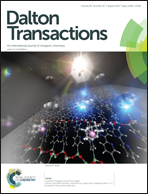A reversible fluorescent-colorimetric imino-pyridyl bis-Schiff base sensor for expeditious detection of Al3+ and HSO3− in aqueous media†
Abstract
A reversible fluorescent-colorimetric imino-pyridyl bis-Schiff base receptor L(N1E,N4E)-N1,N4-bis(pyridine-4-ylmethylene)benzene-1,4-diamine for the detection of both Al3+ and HSO3− in aqueous medium has been developed. Receptor L exhibits an excellent selective fluorescent-colorimetric response toward Al3+. The sensitivity of the fluorescent based assay (0.903 μM) for Al3+ is far below the limit recommended in the World Health Organization (WHO) guidelines for drinking water (7.41 μM). From 1H NMR data, the Job plot and the ESI-MS spectrum, 1 : 2 stoichiometric complexation between L and Al3+ has been established. Receptor L shows remarkable detection ability in a wide pH range of 4–11 and was successfully utilised in the determination of Al3+ in aqueous solution of bovine serum albumin protein, and of HSO3− in real food samples. Moreover, L shows a highly selective colorimetric response to HSO3− by changing its colour from yellow to colorless immediately without any interference from other anions.


 Please wait while we load your content...
Please wait while we load your content...